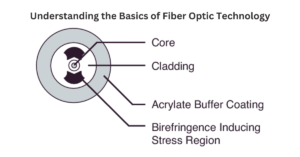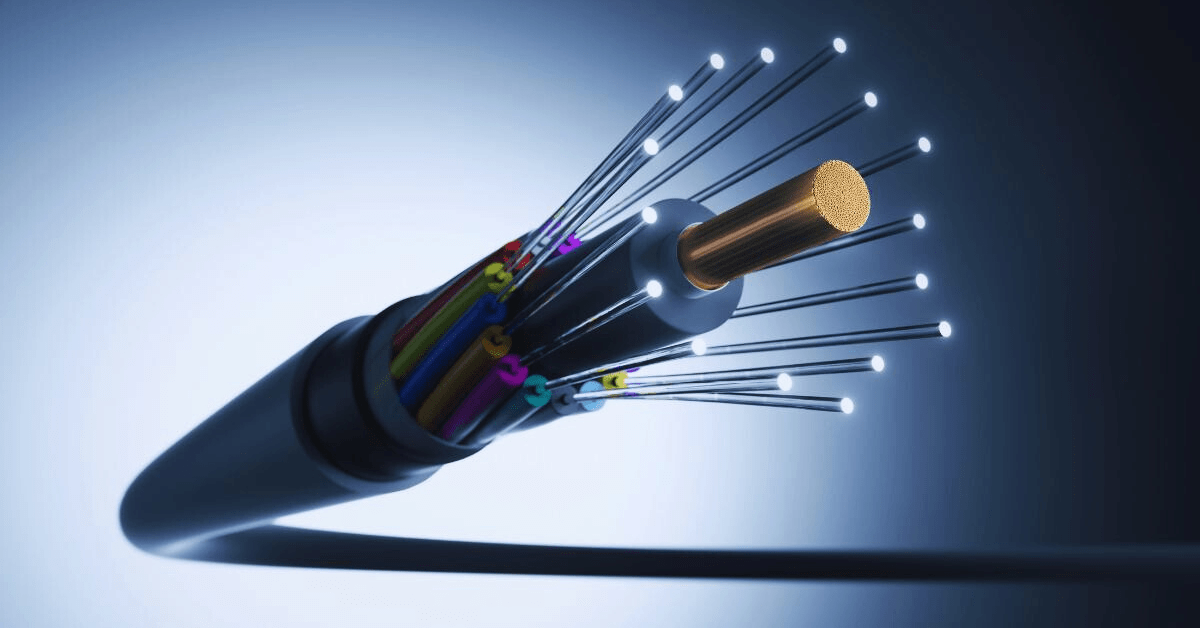Introduction
Fiber optics, which transmits data at the speed of light via thin strands of glass or plastic, is changing how we connect to the Internet. This cutting-edge technology has drastically altered internet access and use. Fiber optics, once a revolutionary idea, underpins modern internet infrastructure today, providing remarkable speed and reliability. The development of fiber optics into a global communication standard will be examined in this section.
Understanding the Basics of Fiber Optic Technology
Fiber optic technology relies on optical fibers, cladding, and a protective jacket. Thin glass or plastic optical fibers are approximately the diameter of a hair. The optical fiber’s cladding has a lower refractive index. Total internal reflection keeps light signals inside the fiber; hence, this design is crucial.
Light refraction and total internal reflection are key to understanding fiber optics. When light passes through fiber, it bounces off cladding, allowing it to travel long distances with little loss. This section will clarify these difficult scientific principles and explain how they improve fiber optic technology.

The Workings of Fiber Optic Internet
How do these thin fibers transmit data so fast? Fiber optic cables send data by light instead of copper wires. Fiber optics’ increased bandwidth and speed come from this basic difference.
This section will explain how data travels across a fiber optic cable from light pulses to its destination. The technological advantages of fiber optics over copper wire systems show why it’s the best solution for high-speed Internet.
This is just the beginning, and the rest of the article will follow the same exhaustive approach for each segment, ensuring a full and educational read on fiber optics technology. The last piece will include benefits, environmental impact, security features, prospects, problems, case studies, and interactions with other technologies like 5G, offering a complete guide for consumers and enterprises.
Advantages of Fiber Optic Internet
Beyond high-speed data transfer, fiber optics are used. Its many benefits make it a preferred internet infrastructure solution. One of its biggest benefits is higher bandwidth. Fiber optic cables can rapidly transmit vast amounts of data since they are not physically constrained like copper connections.
Another benefit of fiber optics is reliability. Unlike copper connections, optical fibers are less affected by weather and electromagnetic interference from surrounding electrical equipment. Individuals and enterprises who rely on internet connectivity need this reliability.
Fiber optics also resist environmental variables and are durable. They last longer and cost less than copper wires because they degrade less.
Due to these features, fiber optics is frequently regarded as the best solution for modern internet infrastructure.
Fiber Optics and Internet Accessibility
Fiber optics help bridge the digital gap by improving internet availability worldwide. Because standard broadband connections are expensive and difficult to install, distant and rural areas have been underserved. This technology is key to getting high-speed Internet to them.
Fiber optics have transformed internet access worldwide, as this section will demonstrate. It will show how fiber optics connect communities to the Internet, improving education, healthcare, and economic prospects.
The Environmental Impact of Fiber Optics
Fiber optics are greener than older internet technologies in an environmentally conscious era. Energy efficiency is a major environmental benefit of fiber optics. Fiber optic cables use less energy than copper wires because light signals have less resistance and require less amplification.
This section discusses fiber optics’ environmental benefits. It will examine how fiber optic cables’ longer lifespan and lower energy use cut carbon emissions, supporting global climate change initiatives.
Fiber Optic Security Features
Internet infrastructure security is crucial in a world of growing cyber threats. Fiber optics are more secure than copper wires. Light transmission makes them more secure against interception and tapping.
The security benefits of fiber optics will be discussed below. The physical features of fiber optic cables increase data protection, giving users and organizations peace of mind about data privacy and security.
The Future of Fiber Optics in Internet Technology
Fiber optics’ future is bright and promises more internet technology advances. Fiber optic cables can provide quicker and more dependable internet connections as technology advances. Research is underway to increase fiber capacity and develop new optical fibers with reduced loss and greater bandwidths.
Fiber optics research and future applications will be covered in this section. We will examine how these advances may change the Internet by providing new services and applications that use high-speed and high-bandwidth fiber optics.
Challenges in Implementing Fiber Optic Technology
The introduction of fiber optic technology is not without problems, despite the benefits being extremely evident. In rural and distant places, fiber optic cable installation is expensive. Replacing copper networks with fiber optics takes time and resources.
Regarding the deployment of fiber optic technology, we will discuss the different related difficulties in this section. We will address the infrastructural, economic, and technical barriers to fiber optics adoption.
Case Studies Success Stories in Fiber Optic Deployment
Implementing fiber optics has resulted in a substantial positive influence everywhere in the world, as seen by the countless success stories documented. This section will give international case studies showing how fiber optics transforms local communities and economies.
The purpose of these case studies is to demonstrate how fiber optics have improved internet access, promoted economic growth, and boosted quality of life. These case studies will contain examples from both industrialized and developing nations. These communities’ experiences will illuminate fiber optics’ ability to connect and include.
Fiber Optics and 5G Technology
The landscape of internet usage may be reimagined due to the convergence of fiber optics and the upcoming 5G technologies. For backhaul, 5G networks use fiber optics to send data quickly between cell towers and the core network. This mix of technologies should boost internet speed, capacity, and latency.
This section will examine how fiber optics and 5G work together to maximize 5G networks. We will explain how this synergy could affect wired and wireless Internet connectivity.
Consumer Guide to Fiber Optic Internet
This section will provide a comprehensive guide for consumers considering switching to fiber optic internet. It will offer advice on selecting the right fiber optic internet provider, understanding different service plans, and what to think regarding speed, bandwidth, and cost.
The guide will also include tips on maximizing the benefits of a fiber optic connection and troubleshooting common issues. This information will assist consumers in choosing and maximizing fiber optic internet service.
Business Applications of Fiber Optics
When implementing fiber optic technology, businesses stand to garner tremendous benefits. Fiber optics supports cloud computing, virtual meetings, video streaming, and online backups due to its speed and reliability.
This section discusses how businesses can use fiber optics. It will demonstrate how fiber optics have improved operational efficiency, consumer experiences, and innovation in several industries.
The Role of Government in Fiber Optic Expansion
Government engagement is common in fiber optic technology expansion and adoption. Government policies, financing, and regulations help this technology thrive. This support can help deploy fiber optic networks, especially in underserved areas.
We are going to talk about the different ways in which the government’s policies and initiatives can affect the growth of fiber optics in this part. Financial incentives, advantageous regulatory regimes, and direct infrastructure investment are examples. We will also examine how government-led initiatives may promote equitable high-speed internet access to close the digital gap.
Conclusion
Fibre optics are a huge leap in internet technology that offers unrivaled speed and dependability and many other advantages it provides. This technology has changed internet access and has major consequences for global connectivity, economic development, and quality of life.
This concluding section will provide a summary of the most important points that were discussed throughout the article. It will examine fiber optics’ transformative effects on individuals and society. We will anticipate future fiber optics advancements and their continuous impact on internet technology.

